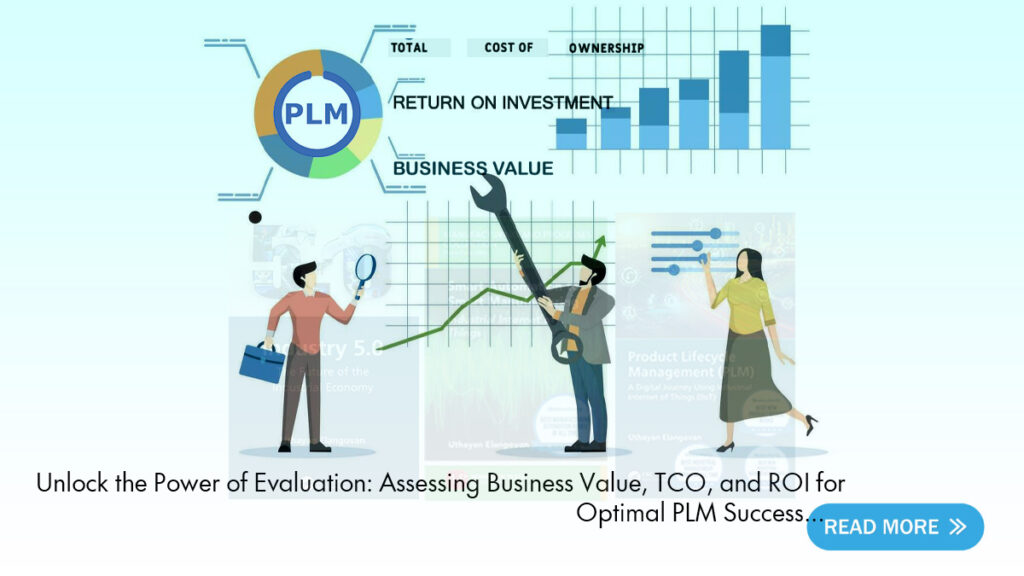Evaluating PLM for Your Organization’s Success will Maximize Business Value
Introduction:
Manufacturing organizations are increasingly recognizing the value of implementing Product Lifecycle Management (PLM) systems. By streamlining processes, improving collaboration, and accelerating time-to-market, PLM can drive significant business benefits. However, selecting the right PLM solution requires careful evaluation considering various factors, including business value, total cost of ownership (TCO), and return on investment (ROI). Here we will explore the key considerations and provide insights to help you make an informed decision that maximizes the potential of PLM in your organization.

Understanding Business Value:
Before delving into the evaluation process, it is crucial to define the business value that PLM can bring to your organization. Consider the specific pain points and challenges faced in your product development lifecycle. Are you struggling with poor collaboration, inefficient change management, or delayed time-to-market? Clearly identify the areas where PLM can have the most significant impact, such as reducing product development cycles, increasing product quality, or enhancing regulatory compliance. By aligning PLM objectives with your organization’s strategic goals, you ensure that the chosen solution directly addresses your unique business needs.
Learn more check out our book on PLM!
Assessing Total Cost of Ownership (TCO):
Evaluating the TCO of a PLM solution goes beyond the initial licensing and implementation costs. It involves considering the entire lifecycle expenses, including hardware, software maintenance, training, support, and future scalability. Calculate both the direct and indirect costs associated with PLM adoption, such as infrastructure upgrades, customization, data migration, and ongoing operational expenses. Additionally, evaluate the potential impact on IT resources, such as internal staff allocation and external consulting requirements. A comprehensive assessment of TCO will enable you to have a realistic understanding of the long-term financial implications and make informed budgeting decisions.
Analyzing Return on Investment (ROI):
Determining the ROI of PLM requires a careful analysis of both tangible and intangible benefits. Tangible benefits include cost savings from process efficiencies, reduced scrap and rework, and shortened time-to-market. Consider the potential improvements in productivity, labor costs, inventory management, and supply chain optimization. Intangible benefits include fostering stronger collaboration, enhancing decision-making processes, and boosting customer satisfaction levels. Quantify these benefits whenever possible, relying on historical data, benchmarks, and industry research. By conducting a comprehensive ROI analysis, you can effectively demonstrate the value of PLM to key stakeholders and secure support for the implementation.
Evaluating Key PLM Solution Factors:
When evaluating PLM solutions, consider the following factors to make an informed decision:
- Functionality: Assess the range of features and capabilities offered by the PLM solution. Does it align with your business requirements? Consider aspects such as data management, change management, collaboration tools, workflow automation, and integration capabilities with other systems.
- Usability: Evaluate the user interface and ease of adoption. Ensure that the PLM solution is intuitive, user-friendly, and adaptable to the specific needs of your organization. User acceptance and engagement are crucial for successful implementation.
- Scalability: Consider the growth potential of your organization and the ability of the PLM solution to scale accordingly. Ensure that it can accommodate increasing data volumes, user numbers, and future business expansion.
- Vendor Reputation: Research the reputation and track record of the PLM solution provider. Evaluate their experience, customer references, industry expertise, and commitment to long-term support and product development.
- Integration: Assess the ability of the PLM solution to integrate with existing systems such as Enterprise Resource Planning (ERP), Computer-Aided Design (CAD), and Manufacturing Execution Systems (MES). Seamless integration ensures smooth data flow and avoids data silos.
Conclusion:
Evaluating PLM for your organization requires a thorough assessment of business value, TCO, and ROI. Define the specific benefits PLM can bring to your organization, consider the comprehensive TCO, and analyze the potential ROI. Evaluate key factors such as functionality, usability, scalability, vendor reputation, and integration capabilities. By conducting a diligent evaluation, you can select the right PLM solution that maximizes business value, drives efficiency, and delivers a strong return on investment. Unlock the full potential of PLM and propel your organization towards greater success in the dynamic market landscape.
Ready to unlock the power of evaluation for optimal PLM success? Partner with Neel SMARTEC, industry-leading business consulting experts, to assess business value, TCO, and ROI. Drive efficiency, collaboration, and accelerated success in your organization. Contact us today and take your PLM journey to new heights.


